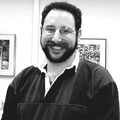
| T H E N I H C A T A L Y S T | J A N U A R Y - F E B R U A R Y 1 9 9 8 |
RECENTLY TENURED
Peter Shields received his M.D. from the Mount Sinai School of Medicine in 1983 and did an internal medicine residency and hematology/oncology fellowship at the George Washington University Medical Center. He did his research training at the Laboratory of Human Carcinogenesis of NCI, and has remained there. He now is the acting section chief of the Molecular Epidemiology Section.
 |
My research in molecular epidemiology is aimed at developing, validating, and applying biomarkers of cancer risk in order to enhance human cancer risk assessments, focus cancer-prevention strategies, and elucidate mechanisms of carcinogenesis. These studies are based on known complexities in carcinogenesis, interindividual variation in carcinogen metabolism, and a priori mechanistic hypotheses.
My most recent objective has been to identify gene-environment interactions, using tobacco smoking as a model for cancer risk. Initially, I had developed methods for the detection of carcinogen-DNA adducts resulting from exposure to polycyclic aromatic hydrocarbons and N-nitrosamines. Using these methods, I then assessed the association between inherited susceptibilities for carcinogen metabolism and the formation of these adducts. In a study of lung tissues from 90 people, I found that the GSTM1 null detoxification genotype was associated with polycyclic aromatic hydrocarbon-DNA adducts and that variants in cytochrome P450s (CYP2D6 and CYP2E1) were associated with 7-methyl-dGp adducts, the latter of which varied by smoking exposure.This in vivo data from a target tissue is consistent with other laboratory findings, and I am now using these methods to study differences in cancer risk by gender and race.
Using methods developed for studying tobacco smoking and lung cancer, my collaborators (Drs. Christine Ambrosone [now at the National Center for Toxicology Research, Jefferson, Arkansas] and Jo Freudenheim [University of Buffalo]) and I set out to study breast cancer risks. We took up this challenge because currently known risk factors do not adequately explain breast cancer risk and there is limited evidence for chemical etiologies. Use of tobacco, for example, is not commonly considered a breast cancer risk factor.
But in a case-control study, we developed the hypothesis that exposure risk factors can be identified by classifying women based on genetic susceptibilities. Indeed, we found that postmenopausal Caucasian women who are NAT2 slow acetylators (involved in the detoxification of aromatic amines) had an increased risk of breast cancer from smoking. For women genotyped for cytochrome P450 1A1 variants, there was a small breast cancer association for smoking less than 29 pack-years. There also was an increased breast cancer risk for smoking in women who carried one variant of CYP2E1. Thus, taken together, these studies suggest that smoking may be a risk factor for breast cancer in susceptible women. Most recently, in this same group of women, we have found that the breast cancer risk of alcohol drinking is modified by metabolism through the alcohol dehydrogenase gene.
While the identification of smoking-related cancer risk is an important goal, determining the risks of becoming a smoker may be more important from a cancer prevention perspective. In collaboration with Drs. Caryn Lerman (Georgetown University) and Neil Caporaso (DCEG, NCI), we have done a study of 466 smokers and nonsmokers to explore genetic-"neurobehavioral" risk factors for smoking. It is known that nicotine stimulates the secretion of dopamine into neuronal synapses, which in turn stimulates dopamine receptors involved in reward pathways.
In our study, a genetic polymorphism in the dopamine transporter gene was associated with smoking risk, attempts at quitting, and duration of successfully quitting. Further, there was an interaction for this gene and a polymorphism in the dopamine D2 receptor gene. Separately, we studied a genetic polymorphism in the dopamine D4 receptor, and, although there was no direct relationship to smoking, one variant was associated with subclinical depression and the risk of smoking in Caucasians, while another variant was associated with smoking in African-Americans. The latter data were particularly striking because the chances of successfully quitting two months after counseling was zero for African Americans with the "at-risk" allele but 35 percent for those without it.
In future work, we will look beyond carcinogen metabolism to interindividual variation in DNA repair, apoptosis, and cell cycle control.
Symposium: Accelerated Drug ScreeningA symposium entitled "From Good Ligands to Good Drugs: Optimizing Pharmaceutical Properties by Accelerated Screening" will be held February 19-21, 1998, in the Natcher Conference Center (Building 45). Cosponsored by NIGMS and the American Association of Pharmaceutical Scientists (AAPS), the meeting will explore ways to optimize the pharmaceutical properties of candidate compounds through accelerated screening early in the discovery phase, rather than later in the drug development phase. Early assessment would alleviate what is becoming a drug development bottleneck. For instance, rational drug design coupled to crystallographic visualization of the target site can lead to the development of drug candidates with potent biological activity, but many of these are subsequently shown to have poor solubility or poor bioavailability, or to be extensively metabolized.. The meeting will begin with an overview of important screening processes, including combinatorial chemistry, genome databases, robotics, and spectroscopic techniques. The next sessions will then focus on important pharmaceutical properties and predictive models in vivo and in vitro. The final session will deal with emerging fields that are likely to affect screening strategies for pharmaceutical properties in the future. Check the AAPS home page at <http://www.aaps.org/edumeet/workshops/nigms/index.html> for more information. Advance registration is encouraged to guarantee admittance, but the registration fee will be waived for all NIH employees, and walk-ins will be welcome, space permitting. |